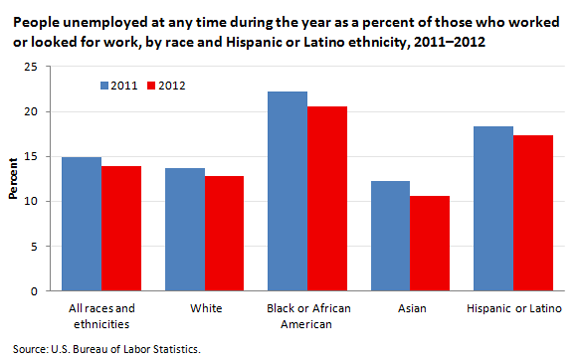An official website of the United States government
 United States Department of Labor
United States Department of Labor
A total of 156.2 million persons worked at some point during 2012. The proportion of workers who worked full time, year round, in 2012 was 63.8 percent, up from 63.3 percent in 2011. Among those who worked in 2012, men were more likely than women to work full time, year round, and Asians and Whites were more likely than Blacks or Hispanics to work full time throughout the year.

| Extent of employment | All races and ethnicities | White | Black or African American | Asian | Hispanic or Latino | |||||
|---|---|---|---|---|---|---|---|---|---|---|
| Men | Women | Men | Women | Men | Women | Men | Women | Men | Women | |
50 to 52 weeks, usually full time | 71.0 | 59.4 | 71.4 | 58.7 | 66.3 | 62.1 | 76.7 | 65.0 | 68.3 | 57.6 |
27 to 49 weeks, usually full time | 8.0 | 7.0 | 8.0 | 6.9 | 8.5 | 7.9 | 5.7 | 5.8 | 10.1 | 7.2 |
1 to 26 weeks, usually full time | 5.6 | 5.2 | 5.3 | 5.0 | 8.1 | 5.9 | 4.7 | 4.4 | 6.0 | 6.2 |
50 to 52 weeks, usually part time | 7.5 | 15.2 | 7.5 | 15.9 | 8.5 | 12.3 | 7.1 | 13.9 | 8.4 | 16.1 |
27 to 49 weeks, usually part time | 3.0 | 5.7 | 3.0 | 5.9 | 2.9 | 4.7 | 2.4 | 4.8 | 2.9 | 5.2 |
1 to 26 weeks, usually part time | 4.9 | 7.6 | 4.9 | 7.6 | 5.8 | 7.1 | 3.3 | 6.1 | 4.4 | 7.7 |
Women of all race and ethnicity groups were more likely than men to work part time in 2012. White, Asian, and Hispanic women were nearly twice as likely to work part time during the year as their male counterparts, and Black women were more likely to work part time than Black men (although the difference was not as great as for the other groups). Among the women who worked part time in 2012, roughly half worked part time for the entire year (50 to 52 weeks).
The "work-experience unemployment rate"—defined as the number of persons unemployed at some time during the year as a proportion of the number of persons who worked or looked for work during the year—fell by 1.0 percentage point over the year to 13.9 percent in 2012.

| Race and ethnicity | 2011 | 2012 |
|---|---|---|
All races and ethnicities | 14.9 | 13.9 |
White | 13.7 | 12.8 |
Black or African American | 22.2 | 20.6 |
Asian | 12.2 | 10.6 |
Hispanic or Latino | 18.3 | 17.3 |
The work-experience unemployment rates for Whites (12.8 percent) and Blacks (20.6 percent) declined from 2011 to 2012, while the rates for Asians (10.6 percent) and Hispanics (17.3 percent) changed little.
These data are from the Current Population Survey. To learn more, see "Work Experience of the Population — 2012" (HTML) (PDF), news release USDL‑13‑2350. Workers are classified as full time if they usually worked 35 hours or more in a week. Persons whose ethnicity is identified as Hispanic or Latino may be of any race.
Bureau of Labor Statistics, U.S. Department of Labor, The Economics Daily, Employment and unemployment experience of the U.S. population in 2012 at https://www.bls.gov/opub/ted/2013/ted_20131223.htm (visited January 01, 2026).

